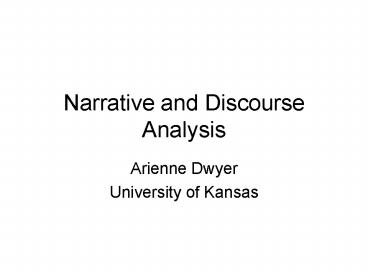Narrative and Discourse Analysis - PowerPoint PPT Presentation
1 / 16
Title:
Narrative and Discourse Analysis
Description:
Most academics (literature, linguistics, political science) study stories ... (in this article) How children learn to construct narratives. Trends in narrative ... – PowerPoint PPT presentation
Number of Views:1408
Avg rating:3.0/5.0
Title: Narrative and Discourse Analysis
1
Narrative and Discourse Analysis
- Arienne Dwyer
- University of Kansas
2
I. What is narrative?
- A way of recapitulating past experience (Labov
Waletsky) - Events presented in temporal sequence
- referential and evaluative
- Most academics (literature, linguistics,
political science) study stories - But not all narratives are stories.
- Non-story narratives Historical discourse,
courtroom testimony - they lack features of stories (e.g. testimony by
definition contains no evaluation)
3
Text
- Written texts manuscripts, books, articles,
advertisements (gtliterary criticism, philology,
text analysis) - Spoken texts conversations, songs, stories,
speeches (gt folklore, soc. of lg.) - Cultural texts kinship terminology, political
symbols (gt semiotics, anthropology, critical
theory) - The act of writing these down is interpretive
4
Structure interpretation
- Structure
- Macro-structure Orientation, evaluation,
complicating action (plot), resolution - Features clauses, particles, exclamations
- Devices repetition, alliteration, audience
interjections - Semantic interpretations
- Coherence (How does it hang together?)
- Intention (What does the speaker mean?)
5
Evaluation in Narrative
- Conveys speaker attitude towards events
- Conveys why the speaker believes the events are
worthy of display - How do we analyze evaluation?
- Formally (breaks between types of clauses)
- Semantically (range of meanings)
- Culturally (shared knowledge, iconic white)
6
Reading A Constructivist approach to Narrative
Development
- How narrative is socially constructed
- Genre (type of text gt different forms/functions)
- Viewpoint of narrator, of audience
- Agency (who is active/in power/in control?)
- I broke the glass vs. The glass broke
- (in this article) How children learn to construct
narratives
7
Trends in narrative analysis
- Structuralist (19th, early 20th c) Propp
- classification of structure and genre
- Text linguistics (1970s-)
- Ethnography of Speaking, Ethnopoetics
(1980s/90s-)
8
Ethnolinguistic analysis
- Paricipant prominence
- Discourse coherence - continuity and
discontinuity - numerically patterning utterances and episodes
- 3. Narrative scenes, or episodes
- Marked off by what constituents?
- prosodic markers (intonation etc)
- pause phrasing
- syntactic markers (connectores, particles)
- Stylistic markers (repetition, parallelism)
- 4. The larger narrative frame
- Bracketing
- Audience participation (context)
9
Types of narrative
- Written prose fiction, epic poetry, nonfiction
(autobiography, memoirs), letters, court
testimony, news reports, math problems,
advertisements.... - Spoken speeches, jokes, interviews,
conversations, stories.
10
The importance of context
- What is the purpose of narration?
- display e.g. courtroom testimony
- convincing e.g. political speech
- creating identity/solidarity e.g. origins story
- Who is the intended audience?
- yesterdays musicians - Hungarian audience?
- What shared knowledge is required to interpret
the narrative? - use of symbols
- formal/informal language speakers intention
11
Spoken narrative
- Geser (b)
- A long time ago in a wealthy mans house there
lived a girl who was a cook. - She was used as a slave.
- She was used as a slave, and in time her
belly became large. - Her belly became large, and her aunt did not
agree. - It wouldnt do to have this slave give birth at
home. - Have her give birth somewhere far away
said. - took her far away
- her aunt did not approve.
- that the slave was used.
- Far away, they gave her an old horse.
- It was not an old ox, but an old dog that they
gave her. - They came to bury her in a cave
- and her uncle took her there.
- After digging a large pit, they buried her
Then the old ox was buried up to its horns. end
XIB. XIIA0-
12
II. Discourse analysis
- 1. Inference and interpretation (What is the
speaker/writers meaning?) - Characterizes how participants go about the
process of interpreting meaning - Conversational meaning reciprocal,
- Reading and writingrdg/wrtg non-reciprocal)
both interactive - Based on interpretive rules (these show how
stretches of speech are understood as having
particular significances) - 2. Explains context of use
- Portrays structure of text/social transaction by
imposing some framework on the data - Structure is suprasentential
- Framework may be implicit or explicit
- Like text linguistics Ethnography of speaking
- Based on realization processes (these show
relation of function to lexico-grammatical
realization)
13
(AUCA/State dept example)
14
Concerned with
- language use beyond the boundaries of a
sentence/utterance, - the interrelationships between language and
society and - the interactive properties of everyday
communication.
15
Subfield conversation analysis
- Narratives are seen
- -not so much as structural realisations,
- -but as interactive accomplishments
- involve audience uptake
- involve negotation of an "extended,
monological" turn in conversational talk - cf. the work of Harvey Sacks.
- -speaking turns, adjacency pairs, overlap
16
Text, Discourse, Narrative
- text analysis
- linguistics (functional, pragmatic)
- critical sociology etc. (everything is
potentially a text) - hermeneutics (interpretation) theories of
interpreting texts (narrowly, religious texts),
but now (by philosophers) more generally even for
discursive text. - Semiotics culture as a system of signs e.g.
Ricoeur (lt Gadamer lt hermeneutic theory)






























